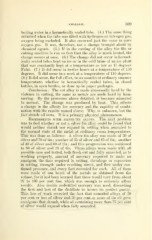Page 635 - My FlipBook
P. 635
AMALGAM. 309
boiling water in a hermetically sealed tube. (4.) The same thing
occurred when the tube was filled with hydrogen or nitrogen gas,
oxygen being excluded. It also occurred just the same in pure
oxygen gas. It was, therefore, not a change brought about by
chemical agents. (5.) If in the cutting of the alloy the file or
cutting machine is run so fast that the alloy is much heated, the
change occurs at once. (6.) The change did not occur in hermet-
ically sealed tubes kept on ice or in the cold brine of an ice plant
that was constantly kept at a temperature as low as 17 degrees
Fahr. (7.) It did occur in twelve hours at a temperature of 150
degrees. It did occur in a week at a temperature of 110 degrees.
(8.) It did occur, the full effect, in six months at ordinary summer
temperature, whether in hermetically sealed tubes, in closed
bottles, in open bottles, or done up in paper packages.
Conclusion : The cut alloy is made abnormally hard by the
violence in cutting, the same as metals are made hard by ham-
mering. By the processes above detailed, it becomes annealed
to normal. The change was produced by heat. This effects
a change in the affinity for mercury and the rapidity of combi-
nation with the results named above. Why, is vmknown, but the
fact stands all tests. It is a primary physical phenomenon.
Experiments with silver-tin alloys. The next problem
was to find whether or not a silver-tin alloy could be found that
would neither shrink nor expand in setting when annealed to
the normal state of the metal at ordinary room temperatures.
This was done as follows : A silver-tin alloy was made of 30 of
silver and 70 of tin ; another of 35 of silver and 65 of tin ; another
of 40 of silver and 60 of tin ; and this progression was continued
to 80 of silver and 20 of tin. These alloys were made with all
possible care and tested, both fresh cut and fully annealed, as to
working property, amount of mercury required to make an
amalgam, the time required in setting, shrinkage or expansion
in setting, strength under crushing stress, and flow under con-
tinued pressure, and every fact recorded for each. All of them
were made of one batch of the metals as obtained from the
refiner, for it had been learned that these would vary from about
97 to 100 per cent fine, which was enough to seriously affect
results. Also double redistilled mercury was used, discarding
the first and last of the distillate to insure its perfect purity.
This line of work revealed the fact that annealed alloys of 70
per cent or less of silver and 30 per cent or more of tin all gave
amalgams that shrank, while all containing more than 75 per cent
of silver would expand when fully annealed.


